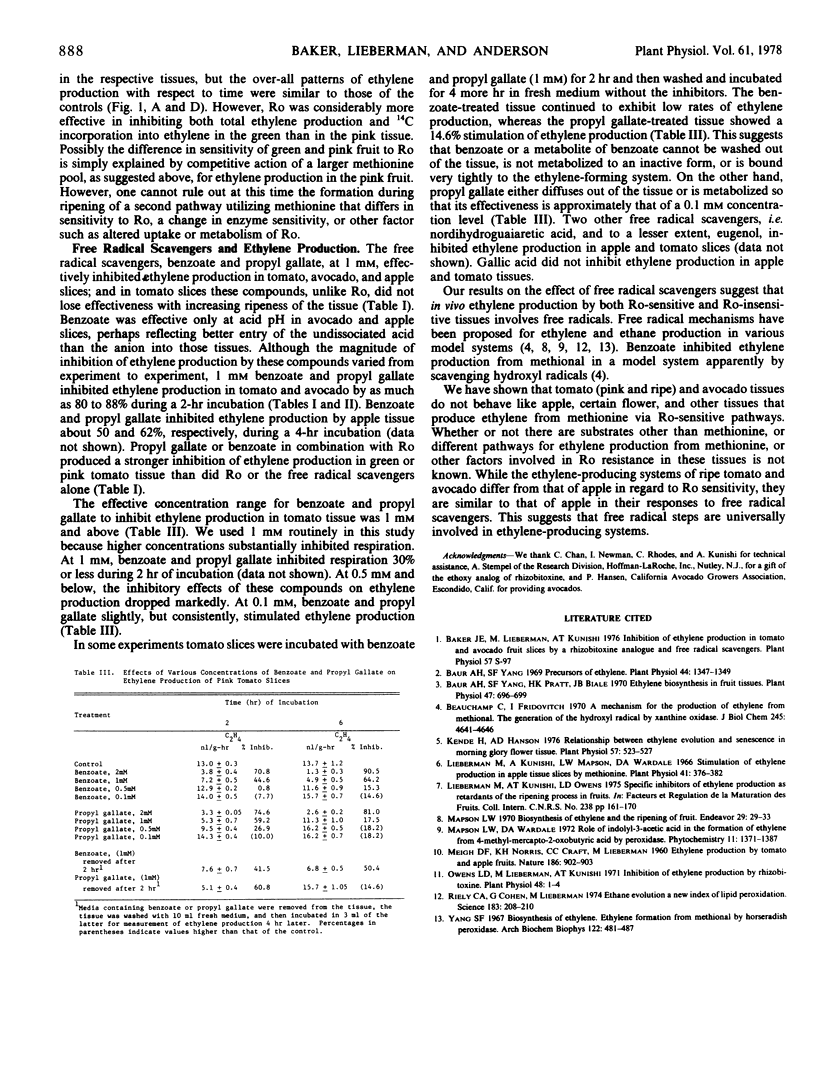Abstract
The rhizobitoxine analog, L-2-amino-4-(2-aminoethoxy)-trans-3-butenoic acid (Ro), which effectively inhibits ethylene production in apple (Malus domestica Borkh.) and other tissues at concentrations at about 68 micromolar, inhibited ethylene production by about 50 to 70% in green tomato (Lycopersicon esculentum Mill.) fruit slices but only by about 15% in pink and ripe tomato tissue slices. Ethylene production in climacteric-rise and postclimacteric avocado slices was likewise relatively insensitive to 68 micromolar Ro. At 340 micromolar Ro, inhibition of ethylene production increased up to 50% in pink tomato slices, whereas 680 micromolar Ro was required to inhibit ethylene production by 30% in avocado slices. Incorporation of 14C from [14C]methionine into ethylene in green and pink tomato tissues was inhibited by Ro to about the same extent as inhibition of total ethylene production. Results thus far are inconclusive as to the mechanism of Ro resistance in tomato and avocado tissues. At 1 millimolar, free radical scavengers such as benzoate, propyl gallate, nordihydroguaiaretic acid, and to a lesser extent, eugenol, inhibited ethylene production in both Ro-sensitive (green tomato and apple) tissues and Ro-resistant (pink tomato and avocado) tissues. Therefore, free radical steps are suggested in the ethylene-forming systems.
Full text
PDF


Selected References
These references are in PubMed. This may not be the complete list of references from this article.
- Baur A. H., Yang S. F., Pratt H. K. Ethylene biosynthesis in fruit tissues. Plant Physiol. 1971 May;47(5):696–699. doi: 10.1104/pp.47.5.696. [DOI] [PMC free article] [PubMed] [Google Scholar]
- Baur A. H., Yang S. F. Precursors of ethylene. Plant Physiol. 1969 Sep;44(9):1347–1349. doi: 10.1104/pp.44.9.1347. [DOI] [PMC free article] [PubMed] [Google Scholar]
- Beauchamp C., Fridovich I. A mechanism for the production of ethylene from methional. The generation of the hydroxyl radical by xanthine oxidase. J Biol Chem. 1970 Sep 25;245(18):4641–4646. [PubMed] [Google Scholar]
- Kende H., Hanson A. D. Relationship between Ethylene Evolution and Senescence in Morning-Glory Flower Tissue. Plant Physiol. 1976 Apr;57(4):523–527. doi: 10.1104/pp.57.4.523. [DOI] [PMC free article] [PubMed] [Google Scholar]
- Lieberman M., Kunishi A. Stimulation of ethylene production in apple tissue slices by methionine. Plant Physiol. 1966 Mar;41(3):376–382. doi: 10.1104/pp.41.3.376. [DOI] [PMC free article] [PubMed] [Google Scholar]
- Owens L. D., Lieberman M., Kunishi A. Inhibition of ethylene production by rhizobitoxine. Plant Physiol. 1971 Jul;48(1):1–4. doi: 10.1104/pp.48.1.1. [DOI] [PMC free article] [PubMed] [Google Scholar]
- Riely C. A., Cohen G., Lieberman M. Ethane evolution: a new index of lipid peroxidation. Science. 1974 Jan 18;183(4121):208–210. doi: 10.1126/science.183.4121.208. [DOI] [PubMed] [Google Scholar]
- Yang S. F. Biosynthesis of ethylene. Ethylene formation from methional by horseradish peroxidase. Arch Biochem Biophys. 1967 Nov;122(2):481–487. doi: 10.1016/0003-9861(67)90222-6. [DOI] [PubMed] [Google Scholar]


